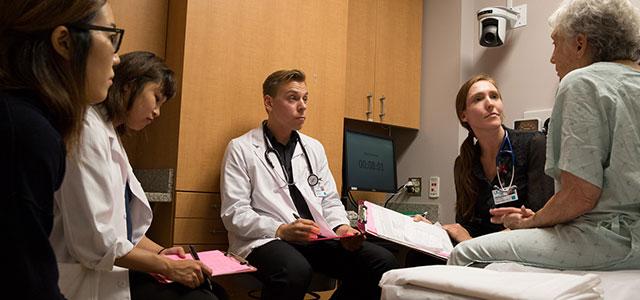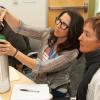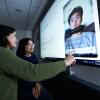
An interprofessional team of students participate in a standardized patient exercise at the UCSF Kanbar Center for Simulation, Clinical Skills and Telemedicine Education to work through real-world clinical challenges in a controlled environment.
Commentary: True Collaborative Training Demands Clinicians Buy In to a Few Simple Rules
Since 1972, when the Institute of Medicine issued a report called Educating for the Health Team, the health professions have recognized that nearly all patients benefit from interprofessional collaborative practice. Yet more than 40 years later, truly collaborative clinical settings remain few and far between. Now, however, we have an opportunity to seize the moment if we can build on a few simple lessons that have emerged from decades of progress by fits and starts.
Certainly, collaborative practice begins with prospective clinicians engaging in interprofessional education (IPE) at the classroom level, and meeting core competencies established by the Interprofessional Education Collaborative. We are making that happen at UCSF, and we know many of our colleagues around the country are doing the same.
Yet when many of our students leave the classroom to engage in hands-on clinical training, it can be hit or miss as to whether they find themselves in a practice that accommodates fully team-based care. The reasons vary. In some cases, learners from different professions may coexist in the clinical setting but only report to faculty preceptors from their own profession. Most faculty preceptors have not had formal training in mentoring trainees from other professions – and it’s a rare setting where policies include incentives to engage in such training. Constraints on time and space remain the most common obstacles to any precepting, and adding interprofessional teaching can feel like an extra burden.
 Angel Chen Despite these challenges, there are some simple things we can do in our own clinical environments to welcome interprofessional collaboration and enrich the education for all learners.
Angel Chen Despite these challenges, there are some simple things we can do in our own clinical environments to welcome interprofessional collaboration and enrich the education for all learners.
First, we must all speak the same language, which means learning to avoid professional jargon and profession-specific terms. This includes everything from how we define our training curriculum to our use of abbreviations and acronyms that may cause confusion in our documentation. When such terms are necessary, we need to create an environment where learners can freely ask for clarification without fear of embarrassment.
Second, we should all hold the role of IPE facilitator and, as such, help define the roles and responsibilities of all of the professionals in the clinical setting. For example, many leaners outside of the nursing profession find it difficult to understand how the role of the nurse practitioner differs from that of a physician. A trained facilitator can help learners understand the different roles and how they can collaborate to improve patient care.
Third, we must move away from the “my learner” versus “your learner” mentality and, instead, consider all trainees “our learners” in the clinical environment. If the steady stream of reports demonstrating that patients benefit from interprofessional collaboration have any validity, then we have a vested interest in providing opportunities for all trainees to learn with, from and about each other. Again here, ensuring all preceptors are formally trained so they can model interprofessional collaboration among themselves is an essential element of successfully moving IPE forward.
The fact that none of this is necessarily easy can no longer be an excuse – not in this era of health care reform. An IPE curriculum should be part of the core curriculum for all learners, rather than the add-on it remains in many settings. To help the clinical environment fully adapt, professional schools must invest fully in faculty and preceptor development, recognize faculty and preceptors who participate in these activities, facilitate the sharing of best practices from exemplary sites and set the expectation that future providers will lead the way in interprofessional collaborative practice. Similarly, practice environments need to prioritize the shift to interprofessional collaboration by allowing the time and space to model and teach it.
Should we achieve these goals, the future is bright – not just for interprofessional education and collaborative practice, but – more importantly – for the many patients who will benefit.



